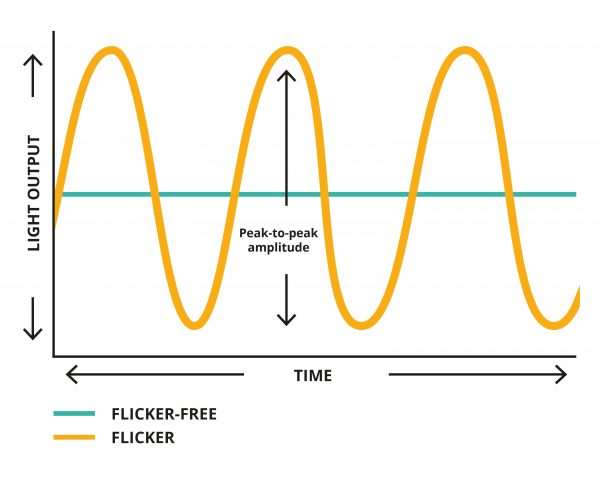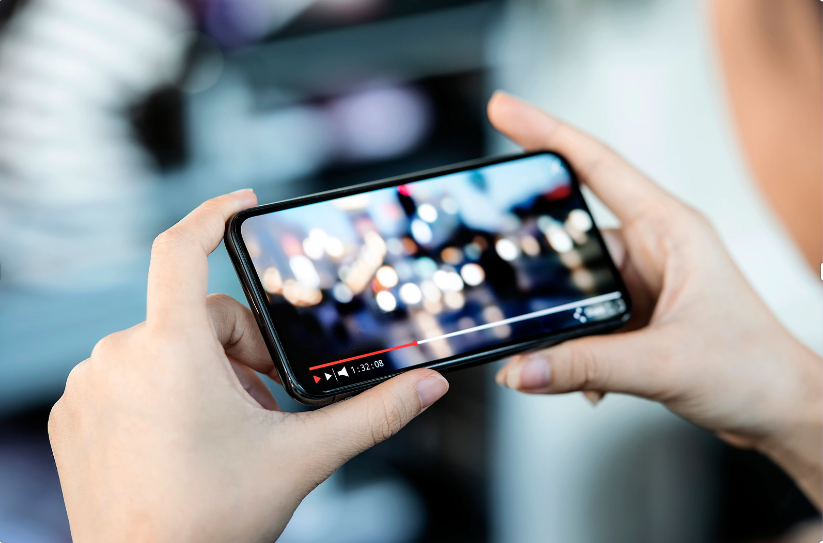

Perhaps you’ve encountered visible light flicker due to faulty wiring connections, worn-out bulbs, and electricity issues. However, a lesser-known flicker type is often overlooked for obvious reasons – it might not be visible to the naked eye.
That’s right; LED lights have invisible flickers that are only seen after taking a shot with your smartphone camera or when they produce a stroboscopic effect on objects in motion.
Because LED flicker isn’t always visible to the eye, we don’t have an apparent reason to switch to a flicker-free LED light. However, a closer look at the topic reveals why a flicker-free light matters.

The flicker in LED light refers to quick fluctuations in brightness occurring several times per second. The swift speed of the flicker often makes it invisible to the eye.
However, it may have neurological and physiological effects on our bodies. For instance, you may experience a headache, eye strain, or fatigue due to excessive light flicker. Even worse, students may have trouble concentrating.
Although flicker is mostly unnoticeable, you may observe it in a few cases.
For example, it gets noticeable when it creates a stroboscopic effect (an optical phenomenon that occurs due to unhindered illumination of an object in motion and causes it to appear stationary or moving slower than the actual rate) on moving objects.
Likewise, you may observe it in the form of vertical streaking lines after clicking photos with your smartphone.
LED flicker comes from two primary sources: Pulse-Width Modulation (PWM) and AC power.
Let’s first talk about how AC power produces flicker. Each Alternating Current (AC) power has built-in fluctuation.
The AC power alternates between negative and positive voltage 50-60 times every second in the form of sinusoidal waves. It is worth noting that a 120-volt AC input voltage represents its average voltage level. This implies it can shift anywhere between 120 and 170 volts.
The AC waveform isn’t compatible because LED lights are manufactured for direct current input. Hence, the electronic parts need to fix the fluctuating alternating current signal.
A simple AC input rectification can make the LED operational. However, it will briefly stop or drastically decrease the emitted light at each of the “valleys” twice per cycle. As a result, the LED bulb flickers between its off and on state 100-110 times every second.
An LED bulb with quality electronic components will convert the AC signal into an even DC signal producing little to no flicker. Therefore, LED bulb electronics directly affect the flicker’s severity.
PWM is the second flicker source in an LED bulb. Pulse-width modification is a deliberate manipulation of a DC power source between the off and on states of the light. It can achieve varying perceptions of brightness levels by changing the relative time between the off and on states.
LEDs have a brightness level between 0-100%. However, to get the illusion of 50% brightness, they are either at 0% (off) or 100% (on) at regular intervals.
PWM offers a quick and functional way to get the dimming illusion. So, the more efficient the PWM frequency, the less the LED flicker.
Any flicker that occurs because of PWM is due to PWM controllers and dimmers with a low frequency.
The brightness of the flickering light source produces rapid fluctuations. The fluctuation’s magnitude can be distinguished with a measure called percent flicker.
To calculate the percent flicker, we measure the difference between the maximum and minimum brightnesses displayed during a flicker cycle.
Light sources with 0% flicker indicate they do not flicker. However, 100% flicker signifies that they fluctuate between on and off states. Generally speaking, a light source with less than 5% flicker helps reduce the flicker effects.

Although LED flicker is almost unnoticeable, the severity of the flicker can be a hassle for highly sensitive individuals.
While you can use a light meter or oscilloscope to determine the extent of flicker, the device costs a few hundred dollars per test unit, which isn’t a practical option for most people.
Fortunately, you can check the flickering intensity using a smartphone’s built-in camera app. Choose the Slow-Motion video setting and point it toward the light source – you want to check. Then, hit record and stop it after 4-5 seconds.
Now, play the video and carefully watch it. You’ll see a repeated flicker or flashing if your LED light is the culprit. However, if the light source is stable, you aren’t encountering a flicker issue.

Flicker problems are highly unlikely when shooting outdoors. However, they can be a nuisance when shooting indoors because of how noticeable the flicker is.
You may assume that tungsten and LED lighting do not flicker because they are DC-powered. However, this isn’t the case for numerous applications.
Tungsten bulbs do not flicker under normal conditions. However, when using an AC power source, the bulb’s filament heats up and cools down 60 times a second.
The heated filament glows and continues to emit light even when cooling down. So, when the next cycle begins, it starts to glow again.
Generally, the human eye cannot see it because all of it happens too quickly. The flicker isn’t perceivable under normal shooting conditions because the camera captures the same light pulses in each frame.
However, as the camera frame rates are increased, you’ll have frames with inconsistent light pulses exhibiting flicker.
Therefore, the pulses must align with the frame rate to shoot a stable, consistent video, which is possible with a flicker-free LED light.
The severity of the flicker effect varies depending on the light source because different light sources exhibit different flicker frequencies.
The best way to mitigate the flicker effect is to opt for flicker-free LED lighting.
Not only do they minimize distortion in video recording, but they also reduce eyestrain, headaches, and other problems associated with light flicker.
Luckily, the Redgrass R9 Desk Lamp caters to your needs by offering a flicker-free light source. You can study, paint, or sew without straining your eyes or losing concentration.